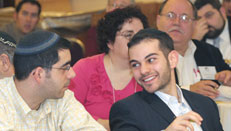 |
||||||||||||
| Weekly Parsha | ||
| Current Week | ||
| Parsha Archives | ||
| Business Ethics | ||
| Dr. Malamet Speaks Out | ||
| TiM MP3 Library | ||




A Thought for the Week with Rabbi Jay Kelman |
 The number four plays a significant role at the seder. There are the four questions, the four children and the four cups of wine. G-d upon appearing to Moshe uses four expressions of redemption in foretelling the exodus. Is this just a coincidence or are the "fours" possibly connected? The Talmud tells us "that the parents must teach according to the intelligence of the child", elaborating on the intricacies and meaning of the pesach experience. Some children (and adults) only have the ability or interest to ask simplistic questions, whereas for others only a sophisticated response will do. Of course it is the parents role to assess each child properly and teach them accordingly. With this in mind perhaps we can see a parallelism between the four questions and the four children. The first question revolves around the chametz and matza. By definition the ingredients of matza are those same ingredients that produce chametz. The line between chametz and matza is fine indeed. The distinguishing factor is that of time. The proper use of time is the first ingredient necessary for the aspiring chacham. It is amazing how much can be accomplished by efficient use of time and by not wasting any valuable moment. This is why bitul z'man or time frittered away is considered such a serious religious offence. While some have the G-d given talents of a chacham, for others much effort and toil is required. Similarly the leavening process can be delayed if one is "working" on the dough by kneading it. The shape of chametz and matza are also instructive. The flatness of matza symbolises humility an indispensable trait for a true wise person. The rising of the chametz symbolises the arrogance of one who is not willing to learn from those "below" him. An arrogant person while perhaps knowledgeable can never be a true chacham which Pirkei Avot defines as "one who learns from everybody." The second question dealing with the eating of marror corresponds to our second child, the rasha . Life has many bitter moments and the Jewish people have experienced far too many of these over the years. Many Jews only want to participate in the sweet aspects of being a Jew, a beautiful seder or a nice Friday night meal. While this is important, it is not enough. Being a Jew means observing Tisha B'av, it means not being afraid to identify as a Jew even though it may involve financial or physical sacrifice. Growing as a Jew takes work, and work is something the rasha is not willing to do. "What is this work unto you" he "asks" mockingly. The third question deals with the dipping of the karpas in salt water and the marror in charoset. At first glance there seems no connection to our third son the Ta'am. This is because most people translate ta'am as a simpleton, who unlike his two older brothers lacks intellectual acumen and can only ask ma zot , what is this? However one can interpret ta'am along the lines of "Yaakov ish ta'am" (Genesis 25:27), Jacob was a man of pure faith. Ta'am comes from the same root as tamim meaning wholesome and pure. The charoset, the midrash teaches us, symbolises the purity of faith of the Jewish women in Egypt who unlike their husbands, did not despair despite the trying circumstances. They seduced their husbands under the apple trees, convincing them that yes, one must have children even under conditions of slavery. In fact had it not been for Miriam convincing her father regarding the need to procreate, Moshe would not have been born. Our best response to tyrants is to ensure Jewish continuity by continuing to have children. Life may be full of tears like the salt water, but we maintain our hope that our children will have a better future. The fourth question deals with the fact that as kings for a night, we sit back, relax and recline as we eat. While reclining may have been a sign of freedom during Roman times it surely is not so today. Yet we retain this custom to show that despite the best efforts of the Romans we have survived and even prospered while the "holy Roman empire" is long gone. The fourth child is one who really knows how to ask but has no interest in doing so. His heritage and the religious practices of his ancestors have no meaning to him. Jewish history is irrelevant. This apathetic child who has no understanding of his link in a chain dating back thousands of years is in danger of being lost to the Jewish people. For him there will no reclining. Pesach is the holiday of redemption. This means a chacham and a rasha sitting together and talking to each other. When that happens the Jew who is turned off by the bickering may well be interested in exploring his roots a little deeper. By using the wonderful examples of our ancestors we can learn to maintain our purity of belief and practice in this corrupt world. If we do so then we can rest assured that Eliyahu Hanavi will soon show up in person to herald the final redemption. May it arrive speedily. |
|
|

 |
 |